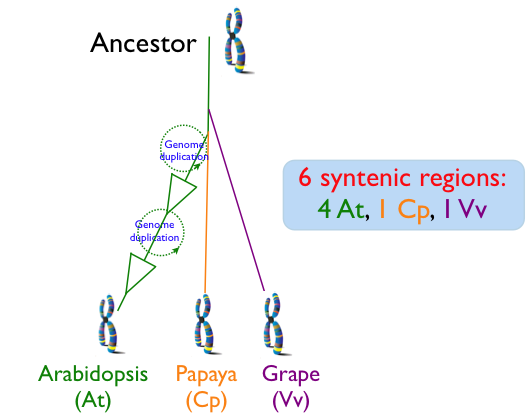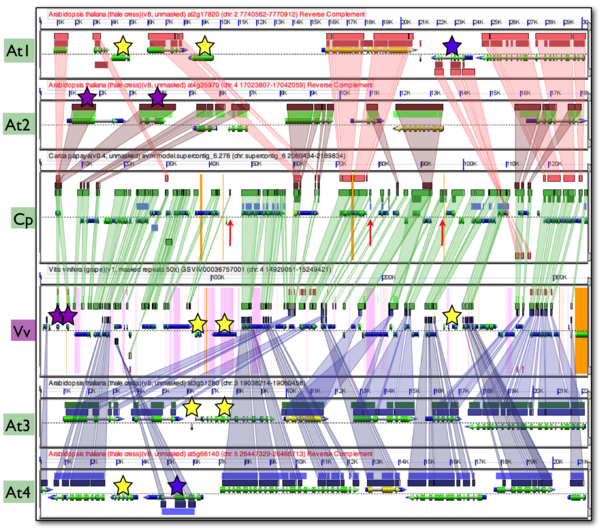Difference between revisions of "GEvo-4at-cp-vv"
| Line 1: | Line 1: | ||
| − | [[Image:GEvo-4-at-cp-vv.png|thumb| | + | [[Image:Genome-phylogeny-At-Cp-Vv.png|thumb|600px|right|Since their divergence, the Arabidopsis lineage has undergone two sequential whole genome duplication events while papaya and grape have had none. This means that for each genomic region of grape, there is one corresponding syntenic region in papaya, and four corresponding syntenic regions in arabidopsis. ]] |
| − | + | ||
| + | [[Image:GEvo-4-at-cp-vv.png|thumb|600px|right|Syntenic comparison for 4 regions from Arabidopsis (At1-4), and one each from Cp and Vv]] | ||
| + | |||
| + | =Comparison of syntenic regions among ''Arabidopsis thaliana'', ''Carica papaya'', and ''Vitis vinifera''= | ||
| + | Since the divergence of ''Arabidopsis thaliana'' (At), ''Carica papaya'' (Cp; papaya), and ''Vitis vinifera'' (Vv; grape), the Arabidopsis lineage has undergone two sequential whole genome duplication events, while the genomes of papaya and grape have not. This means that for every genomic regions of grape, the most basal of these lineages, there is one corresponding syntenic region in papaya, and 4 corresponding syntenic regions in arabidopsis. While whole genome duplication events contemporaneously create a copy of every chromosome and all their underlying [[genomic features]] (e.g. genes), over evolutionary time, many of the duplicated features are lost from [[homeologous]] region or its partner region. While this diploidization process will tend to return a genome's gene content to one that is more similar to the pre-[[polyploid]] ancestor, the overall structure of the genome will be changed as formerly neighboring genes may be dispersed on different derived homeologous chromosomes. This process of homeologous gene loss following whole genome duplication events is known as [[fractionation]]. Comparison of fractionated homeologs to an outgroup syntenic genomic region that has not had its own separate whole genome duplication event will yield an expected pattern: the outgroup genomic region will contain nearly the entire gene content of the fractionated syntenic regions, and the genomic arrangement of these genes will be collinear. In addition, the outgroup syntelogs of the fractionated homeologs will be intercalated with respect to one another. | ||
Revision as of 17:33, 25 August 2009

Comparison of syntenic regions among Arabidopsis thaliana, Carica papaya, and Vitis vinifera
Since the divergence of Arabidopsis thaliana (At), Carica papaya (Cp; papaya), and Vitis vinifera (Vv; grape), the Arabidopsis lineage has undergone two sequential whole genome duplication events, while the genomes of papaya and grape have not. This means that for every genomic regions of grape, the most basal of these lineages, there is one corresponding syntenic region in papaya, and 4 corresponding syntenic regions in arabidopsis. While whole genome duplication events contemporaneously create a copy of every chromosome and all their underlying genomic features (e.g. genes), over evolutionary time, many of the duplicated features are lost from homeologous region or its partner region. While this diploidization process will tend to return a genome's gene content to one that is more similar to the pre-polyploid ancestor, the overall structure of the genome will be changed as formerly neighboring genes may be dispersed on different derived homeologous chromosomes. This process of homeologous gene loss following whole genome duplication events is known as fractionation. Comparison of fractionated homeologs to an outgroup syntenic genomic region that has not had its own separate whole genome duplication event will yield an expected pattern: the outgroup genomic region will contain nearly the entire gene content of the fractionated syntenic regions, and the genomic arrangement of these genes will be collinear. In addition, the outgroup syntelogs of the fractionated homeologs will be intercalated with respect to one another.
